“I just ate a handful of jelly beans. Is that a problem?”
That was an actual text I sent to a bodybuilder friend years ago. I was completely serious.
I was cutting for the first time and the handful of jelly beans weren’t on my meal plan. I knew very little about how dieting actually works and so I worried that I had somehow set myself back.
Silly, of course, but it illustrates a point:
The sheer amount of bad information out there on weight loss and meal planning can turn even “smart” people into superstitious paranoids.
Well, I’ve learned a lot since then. And I’ve used what I’ve learned to write books and articles that have helped hundreds of thousands of people, and many are getting into the best shape of their lives.
I can do the same for you, starting right here, right now, with this article.
In the next ten minutes, you’re going to learn my 7 best tips for making weight loss meal plans that not only work but are, dare I say, enjoyable.
These recommendations aren’t speculation or theory, either.
They’re practical, time-proven techniques that I’ve learned through personal experience with my own body, through working one-on-one with thousands of people, and through the 4,000+ custom meal plans my team has made for men and women all over the world.
So, if you’re ready to learn once and for all how to create the best possible meal plans for losing weight, keep reading.
Table of Contents
+
Don’t Severely Restrict Your Calories
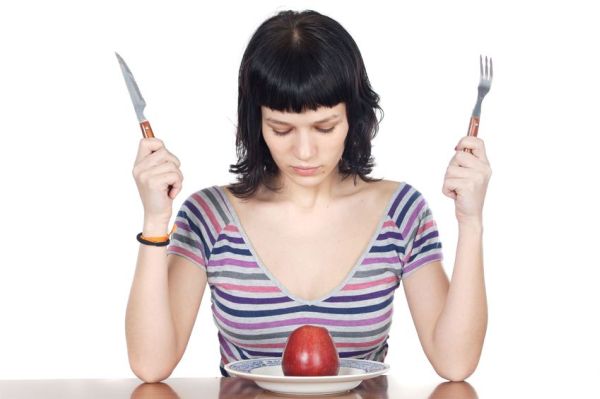
If you could lose weight slowly or quickly, which would you prefer?
And that’s why many people starve themselves. It’s the easiest way to see lower numbers on the scale. It’s also the easiest way to misery, muscle loss, and yo-yo dieting.
You see, many starvation diets have you eating anywhere from 25 to 50% of your total daily energy expenditure. Do this and you’re going to lose weight, of course. But there’s more to consider…
Much of the weight you lose initially is water and glycogen.
When you hear of someone losing 4, 5, 8+ pounds in one week, it’s safe to assume that 20 to 30% is water loss and a fair chunk is a reduction in glycogen levels.
This isn’t a problem per se, but that water and glycogen weight will return once food–and carbohydrate in particular–intake returns to normal.
You can lose muscle easily.
The more you restrict your calories, the more like you are to lose muscle. This is especially true if you’re not doing any resistance training, or doing too much, and if you’re doing too much cardio as well.
The big problem with this is more you lose muscle, the closer you get to a dreaded “skinny fat” physique.
Now, there are forms of very-low-calorie dieting designed to maximize fat loss while preserving muscle, but they have several requirements:
- Basically all calories must come from protein.
- You must do minimal amount of resistance training (just enough to “tell” the body to maintain its lean mass)
- No cardio
And you’d better be ready to suffer.
You think you know hunger, cravings, and mood swings? Try eating (and training on) a diet of 150 to 200 grams of protein per day…and nothing else.
Which brings me to my next point…
You feel progressively worse and worse.
If you’re like most people, you’re going to find very-low-calorie dieting to be miserable.
Common side effects are low energy levels, intense food cravings, mental fog, and depression, and the longer you go, the worse it gets.
How to Calculate Your Calorie Deficit

Now that you know the pitfalls of starvation dieting, you’re probably wondering how to do it correctly.
Well, there’s a lot of debate among “gurus” about how large of a calorie deficit is too large.
It gets especially heated when discussing what’s optimal for athletic types following a high-protein diet, as opposed to untrained, obese individuals eating too little protein.
My go-to research on this matter is a study conducted by scientists at the University of Jyväskylä.
Their subjects were 20 to 35 year-old national and international level track and field jumpers and sprinters with low levels of body fat (at or under 10%), and they split them into two groups.
- A 300-calorie deficit group (about 12% below their total daily energy expenditure),
- and a 750-calorie deficit group.
Both groups ate a high-protein diet, and after 4 weeks, the athletes on a 300-calorie deficit lost very little fat and muscle while the group utilizing a 750-calorie deficit lost, on average, about 4 pounds of fat and very little muscle.
These findings jive with my experiences both with my body and the thousands of people I’ve worked with.
Mild deficits can work if you’re very overweight, or very patient, but as you get leaner, larger deficits become necessary to maintain appreciable fat loss and don’t automatically cause muscle loss.
This is why I recommend a calorie deficit of 20 to 25% when dieting for fat loss.
Find the Best Macronutrient Ratios For You

Now that you know how to optimize your calorie intake, let’s talk about macronutrients.
In case you’re unfamiliar with the word, here’s how the dictionary defines it:
A macronutrient is any of the nutritional components of the diet that are required in relatively large amounts: protein, carbohydrate, fat, and minerals such as calcium, zinc, iron, magnesium, and phosphorous.
The macronutrients we’re most concerned with here are protein, carbohydrate, and fat, and the most important–the one you must get right–is protein.
How Much Protein You Should Be Eating
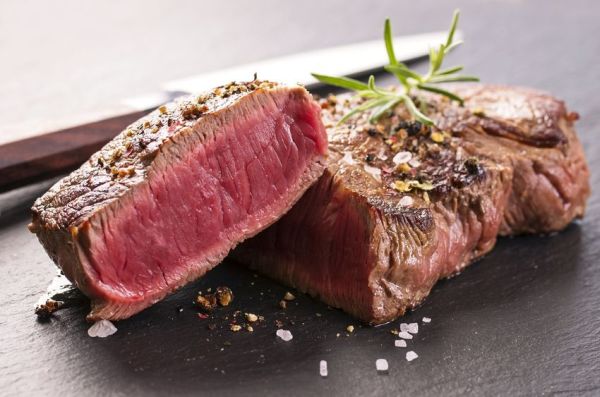
A protein is a molecule comprised of amino acids, which are the “building blocks” of the body.
There are many different types of proteins in the human body and they perform all kinds of functions.
Some are used to build tissues, hair, and nails; others are used to facilitate biochemical reactions; others still are involved in various types of cell signaling (hormones are proteins, for instance); and more.
Muscles are built from “muscle proteins.” The body is able to synthesize some of the requisite amino acids but others, known as essential amino acids, must obtained from food.
The protein you eat provides these essential amino acids. Eat too little and your body will be deficient in essential amino acids, which impairs its ability to build and repair muscle tissue.
This is true whether you exercise or not.
The basic processes whereby cells die and are replaced require these essential amino acids, which is why low-protein dieting is associated with greater muscle loss as people age.
Regular exercise, and resistance training in particular, increases your body’s need for essential amino acids and thus protein.
This is the fundamental reason why athletes need to eat a high-protein diet to optimize body composition and maximize performance.
How much protein is needed, though?
Well, let’s look at some dietary research done with athletes.
First, a study conducted by scientists at McMaster University. They found that a protein intake of 1.3 to 1.8 grams per kilogram of body weight (.6 to .8 grams per pound of body weight) is adequate for stimulating maximal protein synthesis.
They noted, however, that protein requirements are higher in the case of frequent, intense training, which applies to anyone lifting heavy weights 4 to 6 times per week.
Researchers at the University of Western Ontario came to the same conclusion:
1.6 to 1.8 grams of protein per kilogram of body weight seems to be enough for athletes, but higher amounts can be beneficial depending on other factors such as total energy intake, carbohydrate availability, exercise intensity, duration and type, dietary protein quality, training history, gender, age, timing of nutrient intake, and more.
As you can see, athletes and us physically active folk should meet a “bare minimum” intake of 0.6 to 0.8 grams of protein per pound of body weight, but there are circumstances that dictate more.
This research agrees with old school bodybuilding advice that has been kicking around for decades now, which is eating 1 gram of protein per pound of body weight and eating slightly more when in a calorie deficit.
If that sounds excessive to you, it’s not. Here’s a quote from a study conducted by scientists at AUT University:
“Protein needs for energy-restricted resistance-trained athletes are likely 2.3-3.1g/kg of FFM [1 – 1.4 grams per pound of fat free mass] scaled upwards with severity of caloric restriction and leanness.”
That is, if you’re weightlifting regularly and restricting your calories, you should be eating anywhere from 1 to 1.4 grams of protein per pound of fat-free mass (which is everything in your body that isn’t fat). And the larger the calorie deficit and leaner you are, the closer you need to be to the 1.4g lb/ffm number.
And if you’re worried that eating high levels of protein is bad for your kidneys, don’t worry, this myth has been conclusively debunked.
Exact needs are hard to quantify so I choose to err on the side of being a little high. There’s no downside to eating a little more protein than your body needs but there is to eating too little.
My standard recommendations have always been 1 gram of protein per pound of body weight when bulking and maintaining, and 1.2 grams of protein per pound when cutting.
(In the case of obesity, protein intake can be reduced to 1 gram per pound of lean mass.)
How Many Carbs You Should Eat
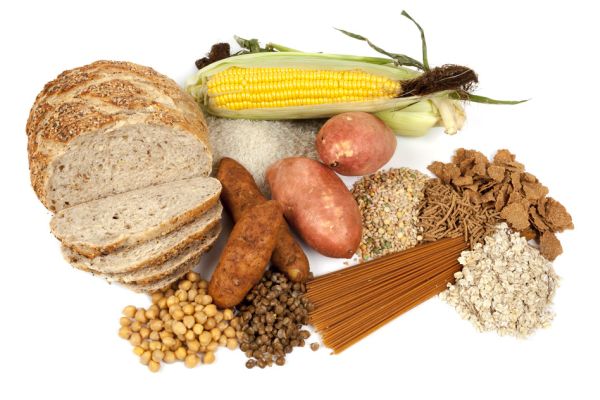
Now that you know how much protein you need, let’s talk carbs and fat.
Ask Google how many carbs you should eat, weed out the idiots, and you’re left with a lot of contradictory answers.
Many well-respected health and fitness authorities argue that low-carb dieting is some sort of panacea. Many others rail against it as just another fad. Many still are in the middle saying “it depends…”
Well, in this article, I explain the science and logic behind my position, which is this:
If you’re healthy and physically active, and especially if you lift weights regularly, you’re probably going to do best with more carbohydrate, not less.
And yes, that applies to both building muscle and losing fat. The reality is a relatively high carbohydrate intake can help you do both.
How Much Dietary Fat You Should Eat
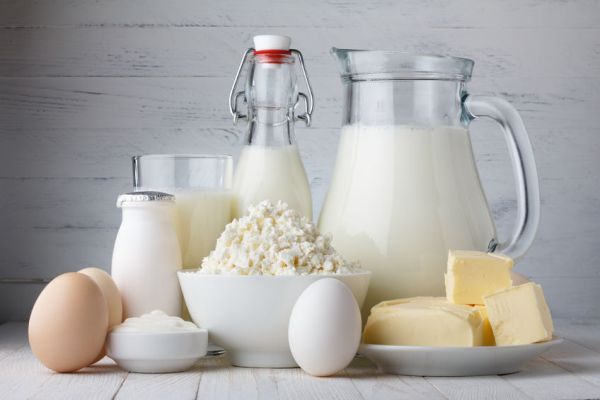
Remember when low-fat dieting was all the rage? When you could buy fat-free just-about-anything and the news story after news story denounced dietary fat as the reason we’ve gotten so fat?
Well, that pendulum has swung hard in the other direction.
Now we’re told that carbohydrates are the real enemy and that we should be eating copious amounts of dietary fat every day if we want to be healthy, lean, and strong.
What gives?
Well, dietary fats play a vital role in the body. They’re used in processes related to cell maintenance, hormone production, insulin sensitivity, and more.
If fat intake is too low, these functions can become compromised, which is why the Institute of Medicine recommends that adults should get 20 to 35% of their daily calories from dietary fat.
Many fitness folk leave it at that and think that anyone, under any dietary conditions, should never go below 20% of calories from fat.
What they’re not realizing, however, is those percentages were worked out for the average sedentary person, who often eats quite a bit less than someone that exercises regularly.
For example, I weigh about 190 pounds, and if I were the average, sedentary type, my body would burn about 2,000 calories per day. Based on that, the IoM’s research says my body would need 45 to 80 grams of fat per day. That makes sense.
But I exercise 6 days per week and have quite a bit more muscle than the average person, raising my total daily energy expenditure to somewhere around 3,000 calories per day.
If we were to blindly apply the IoM’s research to that number, my recommended fat intake would jump to 65 to 115 grams per day.
Do I really need that much more dietary fat simply because I’m muscular and exercise regularly?
The short answer is no.
Based on the IoM research, here’s a good rule of thumb for setting your fat intake:
If you eat 0.2 to 0.3 grams of dietary fat per pound of body weight, you’re giving your body everything it needs.
This will work out to be 20 to 35% of your basal metabolic rate.
Eat Foods You Actually Like
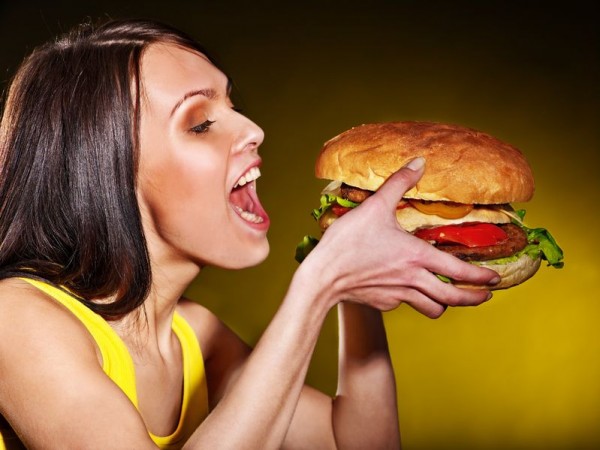
There are far too many myths regarding foods you “can and can’t” eat when you’re trying to lose or gain weight.
Well, when you want to lose weight, how much you eat is what matters most…not what.
So long as you stick to your daily targets for calories and macronutrients, your body will respond accordingly. The foods you eat just don’t matter in this regard.
Now, this knowledge doesn’t give you a license to eat as much junk food as possible. Your body needs micronutrients in addition to macronutrients to stay healthy, vital, and disease-free. Pop Tarts, sugar-laden cereals, and other heavily processed foods just won’t cut it.
So, when you’re working out your meal plan, “saving” a relatively small percentage (5 to 10%) of your daily calories for something “bad” (of little nutritive value) isn’t a problem.
But when you’re stripping your meal plan bare to “squeeze in” a 1,200-calorie banana split, you’re taking it too far.
Eating too many high-calorie processed foods also means your meals will be quite low in overall food volume, which makes them less filling. This also means your stomach will be empty for longer periods of time, which elevates ghrelin levels, further stimulating hunger.
So, follow this rule of thumb and you’ll do great:
Get 80 to 90% of your daily calories from relatively unprocessed, nutrient-dense foods, and you can do whatever you want with the remaining 10 to 20%.
For instance, I get the majority of my calories from a variety of nutrient-dense foods:
- Avocados
- Greens (chard, collard greens, kale, mustard greens, spinach)
- Bell peppers
- Brussels sprouts
- Mushrooms
- Baked potatoes
- Sweet potatoes
- Berries
- Low-fat yogurt
- Eggs
- Seeds (flax, pumpkin, sesame, and sunflower)
- Beans (garbanzo, kidney, navy, pinto)
- Lentils, peas
- Almonds, cashews, peanuts
- Barley, oats, quinoa, brown rice
- Salmon, halibut, cod, scallops, shrimp, tuna
- Lean beef, lamb, venison
- Chicken, turkey
And I “spend” a small portion of my daily calories on something sweet like chocolate or frozen yogurt.
This style of dieting is known as flexible dieting, or “If It Fits Your Macros,” and it’s a phenomenal tool for long-term dietary compliance, craving management, and overall lifestyle enjoyment.
And let’s face it–there’s something perversely gratifying to eating ice cream every day while dieting.
Make Your Meal Schedule Work for You

Read some generic magazine or blog article on losing weight and you’re likely to come across some version of the myth that eating more frequently helps you lose weight faster.
Well, it’s true that breaking down and processing the food you eat causes a “metabolic boost.” This is known as the “thermic effect of food” and it can be quite significant (about 25% of the energy contained in carbohydrate is used to digest and process it, for example).
People have extrapolated from this the theory that eating frequently would keep your metabolism revved up all day, resulting in higher levels of total energy expenditure. Well, it may sound plausible but research shows it doesn’t play out like that.
A study conducted by scientists at the French National Institute of Health and Medical Research involved the analysis of scores of studies with a variety of eating patterns ranging from 1 to 17 meals per day.
Researchers found no difference in 24-hour energy expenditure between low- and high-frequency eating.
What they found instead is that small meals cause small, fleeting increases in metabolic rate and larger meals result in larger, longer-lasting boosts, and it all balances out in terms of total energy expenditure by the end of the day.
The bottom line is there is no metabolic advantage to eating 3, 6, or 9 times per day, and you should do what fits your preferences and schedule.
For instance, if you’re not hungry in the morning or just don’t particularly like eating until lunch, start eating at lunch. No, this won’t cause “metabolic damage” or muscle loss. In fact, it’s the easiest way to follow the “intermittent fasting” style of dieting.
On the other hand, if you’re like me and you like to eat something every few hours, that’s how you should eat.
And if your schedule is erratic, like eating breakfast, skipping lunch, and making it up with a bigger mid-afternoon meal and dinner, there’s nothing wrong with that, either.
Again, work your meal schedule to fit your needs.
Use Meal Sizing to Your Advantage
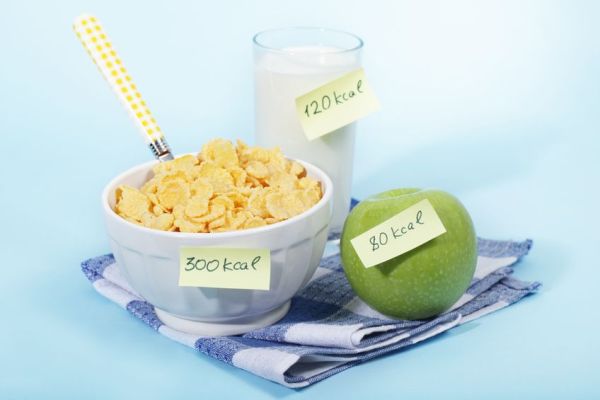
Many people assume that the easiest way to diet is to break up their calorie and macronutrient targets into calorically or macronutritionally balanced meals.
This isn’t true for many people, myself included.
There’s nothing wrong with doing it, of course, but you’re probably not going to find it as enjoyable as tailoring the size of each meal to your preferences.
For instance, these days I like eating several small meals, mainly containing protein, up until dinner. I then eat a larger dinner (about 500 calories) followed by a very large post-dinner meal around 9 PM (about 1,500 calories).
(And in case you’re wondering, this 9 PM meal contains about 250 grams of carbs and no, that doesn’t impair weight loss.)
Other people prefer a very large breakfast followed by progressively smaller meals and ending with a little protein before bed.
The point is, like with meal scheduling, you should tailor your meal sizes to work with your natural hunger patterns and lifestyle preferences.
3 Low-Calorie “Diet Hacks” That Make Meal Plans Better
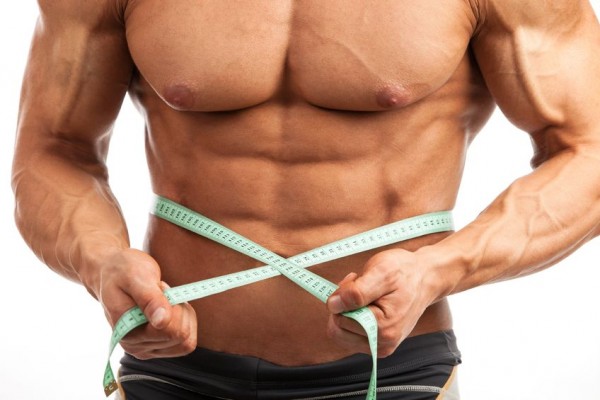
Many people make dieting harder than it has to be by simply being too “hardcore” about it.
No sugar. No processed foods. No starchy carbs. No red meat. And on and on.
Well, I applaud these “clean eaters” for their discipline, but as far as losing fat goes, they’re making it more unpleasant than it has to be.
That said, even a more flexible approach to dieting has its restrictions, simply because the tastiest foods are often the most calorie-dense.
Your average slice of pizza or cup of ice cream has about 300 calories. Nut butters clock in around 100 calories per tablespoon. Whole-fat diary is also loaded too (110 calories for one ounce of cheese!?).
Worse yet, these indulgent types of foods are also very high in fat, which makes them even less feasible when you’re trying to keep your carbohydrate intake high.
Well, despair not. Here are my three favorite ways to break the monotony of dieting and squeeze the most enjoyment out of your calories as possible.
Use PB2 Instead of Peanut Butter
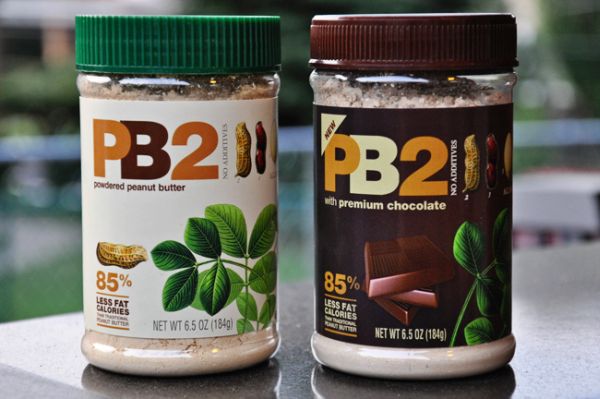
If you’re like 95% of humans, you love peanut butter.
But what sucks about peanut butter? All the damn fat.
And that’s why God created PB2, which is a peanut butter alternative so good it’s not just a diet hack–it’s a life hack.
PB2 is a powdered form of peanut butter that has almost all of the fat removed. You mix it with a little bit of water and it turns back into a peanut butter-like paste, which is quite tasty, and very low calorie (just over 20 calories per tablespoon–yup, you read that right).
It comes in two flavors: traditional and chocolate, and I’m a chocolate fiend so that’s my preference, but the traditional is quite good too.
If you don’t have any, pick it up at Amazon:
Traditional Flavor
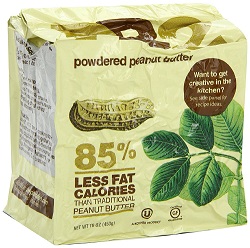
Chocolate Flavor
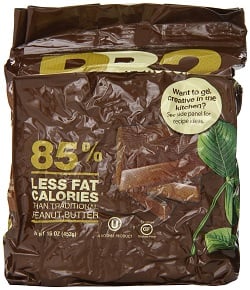
There are plenty of obvious uses for PB2–apple wedges, banana protein pancakes, toast and English muffins, and more–but there’s a whole lot more you can do with it too.
Except when the peanut oil is the main fat in a recipe, PB2 makes a great replacement in peanut butter cookies, shakes, and other sweet treats. It can also be used in savory dishes, particularly in Thai food.
Bolthouse Farms Salad Dressings
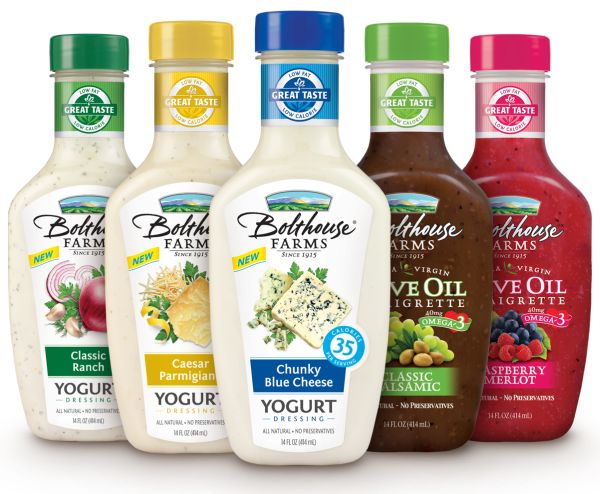
You’re going to love me for this one.
No matter how fancy you get with your salad recipes, if you can’t enjoy them with a good dressing, they’re just not very exciting.
And, of course, the best salad dressings are caloric nightmares. It’s hard to justify allotting several hundred calories to just a few tablespoons of Caesar or Ranch dressing.
What if 2 tablespoons of creamy, delicious salad dressing were only 45 calories though?
And that’s Bolthouse Farms, who makes low-calorie versions of all your favorites using low-fat yogurt, milk, and cheese.
Yes, 2 freaking tablespoons of good Caesar dressing is just 45 calories.
May your salad game never be the same.
Choose Low-Fat Dairy Products
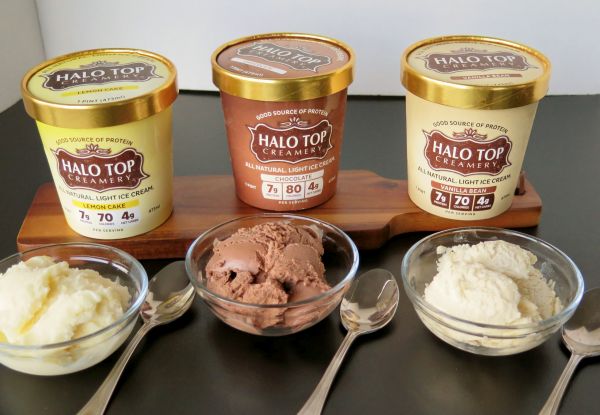
You’ve probably heard that you should cut out all dairy when you want to lose weight, but this is nonsense.
Dairy is delicious and nutritious and makes dieting more enjoyable, and eating it doesn’t impair weight loss in any way, so you shouldn’t cut it out.
Whole-fat dairy is tough to work with, though. Unless you’re following a high-fat diet, you won’t have much room for whole-fat milk, cheese, and the like.
This is why you should just go with reduced-fat options. For example, skim milk, low-fat mayo, low-fat cheeses (parmesan is one of my favorites), and 0 or 2% Greek yogurt can make all types of meals and recipes viable.
You also need to check out Halo Top ice cream.
Ready for this?
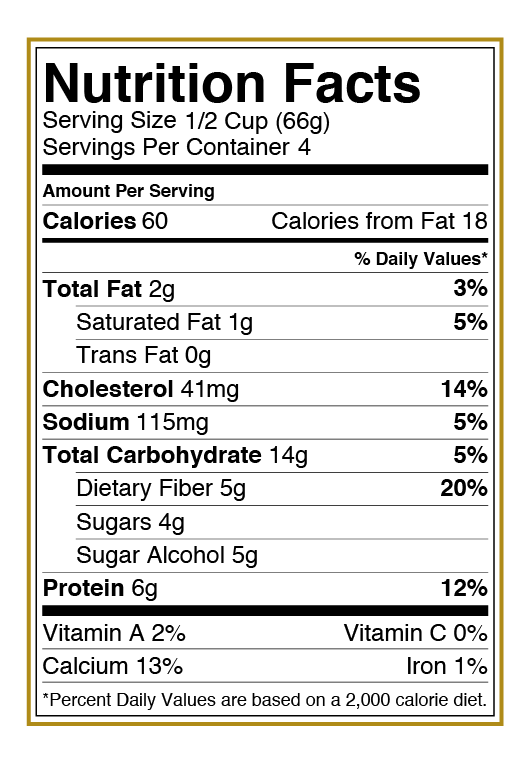
Yes, that’s a 240-calorie pint of ice cream…with 24 grams of protein…that isn’t made with cancer…and that actually tastes good.
You’re welcome.
My favorite flavors are vanilla and strawberry.
Do Your “Cheating” Right
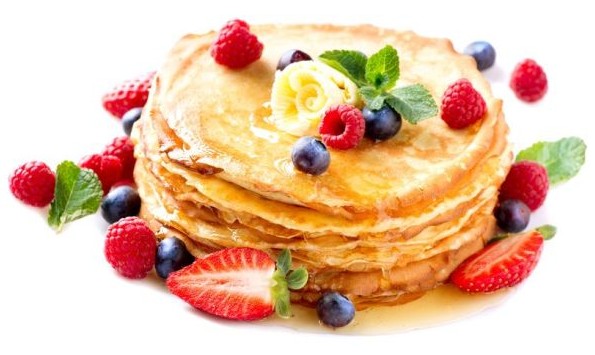
The most common mistakes people make with “cheat” or “free” meals are…
- Cheating too frequently
- Indulging in cheat DAYS, not meals
- Eating too many calories or too much dietary fat in cheat meals
- Drinking alcohol while cheating
Make these mistakes and you’ll never reach your fitness goals.
Avoid them, however, and you can get into incredible shape while still enjoying your favorite culinary sins.
Think Cheat Meals Not Days
Many people struggling with diets talk about “cheat days.” The idea is that if you’re good during the week, you can go buck wild on the weekends.
Well, unless you have a very fast metabolism, that’s not how it works.
If you follow a proper diet and exercise program, you can expect to lose 1 to 2 pounds per week. If you get too crazy with your cheating, however, you can gain it right back (and more!) over a weekend.
And if you’re bulking, you can gain double the fat you normally would have that week.
If you’re currently including cheat days in your routine and aren’t happy with how your body is changing, you’re going to have to cut it out.
The Best Type of Cheat Meal
The best type of cheat meal is high in carbohydrate and relatively low in dietary fat.
There are two reasons for this:
A high-carbohydrate meal causes less body fat storage than a high-fat meal.
Much of the current hysteria over eating carbs comes from an ignorance of what actually happens when you eat them.
Sure, eating too many carbs can make you fatter, but the same goes for protein and dietary fat. And, ironically, the body rarely converts carbs directly into body fat.
You see, chemically speaking, carbs are very different than the types of molecules stored in body fat cells (lipids), and the process whereby carbs are converted into body fat is known as de novo lipogenesis (DNL).
The first thing you need to know about DNL is it rarely occurs under normal dietary conditions.
When you review the literature on overfeeding, you find that carb intake has to be absolutely sky-high (700 to 900 grams per day for several days for DNL to contribute significantly to total body fat stores.
There are exceptions, such as very large infusions of pure glucose (150% of TDEE) and people with hyperinsulinemia, but the above holds in healthy individuals following a normal type of diet.
That said, eating carbs does affect your body fat in another way–it reduces fat oxidation. In other words, it tells your body to stop burning fat for energy and start burning carbs instead.
This effect applies to any dietary fat that you eat, which is chemically similar to body fat and thus is very easily converted and stored. This means that, when combined with carbs (and, more to the point, elevated insulin levels), basically every gram of dietary fat that you eat is stored as body fat.
And as your body fat mass is regulated by the balance between the amount of fat burned versus stored every day, you can probably see how carbs play into this: eat a lot of carbs and you’ll store all the fat you eat and burn little body fat throughout the day.
The more astute readers might now be wondering if you can “biohack” this by eating a diet very high in carbs and very, very low in fats…and the answer is no.
Not only would that be bad for your health, research shows that when dietary fat intake is too low, DNL ramps up to provide the body with vital triglycerides.
Now, remember that all this doesn’t negate or trump the laws of energy balance.
If you’re in a calorie deficit, regardless of how much or little carbohydrate or fat you eat, you will lose fat. And if you’re in a surplus, you will gain.
My point here is just to enlighten you on how carbs directly affect the physiology of fat burning and storage and how we can apply that knowledge to individual (cheat) meals.
Hence my recommendation of going high-carb and not high-fat when you “cheat.”
There are other benefits of high-carb meals (and even days) as well, which I lay out in this article on “refeeding.”
The Bottom Line on Meal Plans for Weight Loss

You now have everything you need to create the best possible meal plans for weight loss.
You know you’ve got everything dialed in when…
- you’re losing 0.5 to 2 pounds per week,
- you’re not chronically hungry,
- you’re not constantly battling cravings,
- you have good energy levels,
- your workouts aren’t heavily impacted,
- and neither is your mood.
Use the strategies laid out in this article and you’ll see how easy losing weight can really be.
What’s your take on meal plans for weight loss? Have anything else to share? Let me know in the comments below!
Scientific References +
- JM, S., P, L., D, D., & K, A. (2003). Hepatic de novo lipogenesis in normoinsulinemic and hyperinsulinemic subjects consuming high-fat, low-carbohydrate and low-fat, high-carbohydrate isoenergetic diets. The American Journal of Clinical Nutrition, 77(1), 43–50. https://doi.org/10.1093/AJCN/77.1.43
- TJ, H., H, D., A, B., GW, R., JC, P., & JO, H. (1995). Fat and carbohydrate overfeeding in humans: different effects on energy storage. The American Journal of Clinical Nutrition, 62(1), 19–29. https://doi.org/10.1093/AJCN/62.1.19
- KJ, A., JP, F., & E, J. (1982). Glycogen synthesis versus lipogenesis after a 500 gram carbohydrate meal in man. Metabolism: Clinical and Experimental, 31(12), 1234–1240. https://doi.org/10.1016/0026-0495(82)90010-5
- A, A., D, C., & RR, W. (1996). Contributions of de novo synthesis of fatty acids to total VLDL-triglyceride secretion during prolonged hyperglycemia/hyperinsulinemia in normal man. The Journal of Clinical Investigation, 98(9), 2008–2017. https://doi.org/10.1172/JCI119005
- RM, M., SJ, B., M, H., WA, C., LJ, B., & AM, P. (2001). De novo lipogenesis during controlled overfeeding with sucrose or glucose in lean and obese women. The American Journal of Clinical Nutrition, 74(6), 737–746. https://doi.org/10.1093/AJCN/74.6.737
- KJ, A., Y, S., T, B., K, A., JP, F., & E, J. (1988). Glycogen storage capacity and de novo lipogenesis during massive carbohydrate overfeeding in man. The American Journal of Clinical Nutrition, 48(2), 240–247. https://doi.org/10.1093/AJCN/48.2.240
- MK, H. (2001). No common energy currency: de novo lipogenesis as the road less traveled. The American Journal of Clinical Nutrition, 74(6), 707–708. https://doi.org/10.1093/AJCN/74.6.707
- GA, B., SR, S., L, de J., H, X., J, R., CK, M., M, M., C, B., S, M., & LM, R. (2012). Effect of dietary protein content on weight gain, energy expenditure, and body composition during overeating: a randomized controlled trial. JAMA, 307(1), 47–55. https://doi.org/10.1001/JAMA.2011.1918
- TJ, H., H, D., A, B., GW, R., JC, P., & JO, H. (1995). Fat and carbohydrate overfeeding in humans: different effects on energy storage. The American Journal of Clinical Nutrition, 62(1), 19–29. https://doi.org/10.1093/AJCN/62.1.19
- G, B., & P, R. (2006). Dairy foods, dietary calcium and obesity: a short review of the evidence. Nutrition, Metabolism, and Cardiovascular Diseases : NMCD, 16(6), 445–451. https://doi.org/10.1016/J.NUMECD.2006.04.004
- F, B., R, M., & AM, P. (1997). Meal frequency and energy balance. The British Journal of Nutrition, 77 Suppl 1(S1), S57–S70. https://doi.org/10.1079/BJN19970104
- RS, S., E, R., M, M., M, O., & DC, R. (1985). The thermic effect of carbohydrate versus fat feeding in man. Metabolism: Clinical and Experimental, 34(3), 285–293. https://doi.org/10.1016/0026-0495(85)90014-9
- X, Y., Y, L., G, X., W, A., & W, Z. (2009). Ghrelin fluctuation, what determines its production? Acta Biochimica et Biophysica Sinica, 41(3), 188–197. https://doi.org/10.1093/ABBS/GMP001
- BJ, R., EA, B., & BA, W. (2000). Increasing the volume of a food by incorporating air affects satiety in men. The American Journal of Clinical Nutrition, 72(2), 361–368. https://doi.org/10.1093/AJCN/72.2.361
- JR, P., & O, D. (2000). Do regular high protein diets have potential health risks on kidney function in athletes? International Journal of Sport Nutrition and Exercise Metabolism, 10(1), 28–38. https://doi.org/10.1123/IJSNEM.10.1.28
- ER, H., C, Z., DS, R., & SR, B. (2014). A systematic review of dietary protein during caloric restriction in resistance trained lean athletes: a case for higher intakes. International Journal of Sport Nutrition and Exercise Metabolism, 24(2), 127–138. https://doi.org/10.1123/IJSNEM.2013-0054
- PW, L. (2000). Beyond the zone: protein needs of active individuals. Journal of the American College of Nutrition, 19(5 Suppl), 513S-521S. https://doi.org/10.1080/07315724.2000.10718974
- SM, P., & LJ, V. L. (2011). Dietary protein for athletes: from requirements to optimum adaptation. Journal of Sports Sciences, 29 Suppl 1(SUPPL. 1). https://doi.org/10.1080/02640414.2011.619204
- KD, T., & RR, W. (2004). Protein and amino acids for athletes. Journal of Sports Sciences, 22(1), 65–79. https://doi.org/10.1080/0264041031000140554
- D, P.-J., KR, S., WW, C., E, V., & RR, W. (2008). Role of dietary protein in the sarcopenia of aging. The American Journal of Clinical Nutrition, 87(5). https://doi.org/10.1093/AJCN/87.5.1562S
- SM, P., & LJ, V. L. (2011). Dietary protein for athletes: from requirements to optimum adaptation. Journal of Sports Sciences, 29 Suppl 1(SUPPL. 1). https://doi.org/10.1080/02640414.2011.619204
- HT, H., JJ, H., J, I., H, K., R, P., T, K., K, M., & AA, M. (2015). Body composition and power performance improved after weight reduction in male athletes without hampering hormonal balance. Journal of Strength and Conditioning Research, 29(1), 29–36. https://doi.org/10.1519/JSC.0000000000000619
- ML, D., JS, G., P, R., SF, S., S, S., & PM, W. (1980). Factors influencing the composition of the weight lost by obese patients on a reducing diet. The British Journal of Nutrition, 44(3), 275–285. https://doi.org/10.1079/BJN19800042
- SN, K., AY, C., & KF, S. (1992). Glycogen storage: illusions of easy weight loss, excessive weight regain, and distortions in estimates of body composition. The American Journal of Clinical Nutrition, 56(1 Suppl). https://doi.org/10.1093/AJCN/56.1.292S
- RR, H., TA, W.-K., L, S., OG, K., & JM, O. (1986). Metabolic consequences of very-low-calorie diet therapy in obese non-insulin-dependent diabetic and nondiabetic subjects. Diabetes, 35(2), 155–164. https://doi.org/10.2337/DIAB.35.2.155










